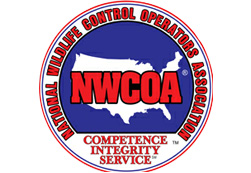NY/NJ OPOSSUM REMOVAL
While people often refer to the animal as a possum, these nocturnal creatures are actually called opossums throughout North America. The “O” is silent. Aside from the great outdoors, opossums can be found in attics and cellars. These creatures are harmless and very shy so it’s not unusual to never see them within your home.
The opossum is about the size of a house cat with adult males weighing an average of 5.5 pounds and adult females an average of 4.0 pounds. They have long, dense body fur that is usually a grayish-white color, although some opossums in the southeastern U.S. are darker. An opossum face is white with a pointed snout and whiskers. An adult opossum has 50 teeth, quite a lot, and is not afraid to bare its teeth when scared or angry (hence the phrase “grinning like a possum”). Its tail is about a foot long and has very little hair on it. The tail is prehensile which means it is can be used to grasp onto objects such as tree limbs.
Opossums are fairly widespread in continental North America, found as far north as the U.S./Canadian border and as far south as Costa Rica. In the United States, opossums are found in the eastern two-thirds of the country and along a narrow strip on the Pacific coasts of California, Oregon, and Washington.

Opossums In Different Environments
Opossums are not constrained to any specific habitat type, thus they are found in many different areas from cities and towns to rural areas. However, across their range, they appear to be most numerous in wooded areas adjacent to water bodies such as creeks, rivers, and lakes.
Opossums are omnivorous, meaning they eat both plant and animal substances. They eat hard and soft mast: acorns, berries, and other fruits. Opossums consume insects and other arthropods, as well as bird eggs, bird nestlings, and small mammals. They will also kill and eat venomous snakes. Opossums are remarkably immune to snake venom. Dead animals, garbage, and even young of their own species round out an opossums diet.

Opossums are not constrained to any specific habitat type, thus they are found in many different areas from cities and towns to rural areas. However, across their range, they appear to be most numerous in wooded areas adjacent to water bodies such as creeks, rivers, and lakes.
Opossum Diet
Opossums are omnivorous, meaning they eat both plant and animal substances. They eat hard and soft mast: acorns, berries, and other fruits. Opossums consume insects and other arthropods, as well as bird eggs, bird nestlings, and small mammals. They will also kill and eat venomous snakes. Opossums are remarkably immune to snake venom. Dead animals, garbage, and even young of their own species round out an opossums diet.
Opossums can access garbage cans. They will also eat pet food if left outside. They can easily climb stairs to get these items on porches and decks. Opossums also target bird feeders. The key to preventing these types of situations is to secure or remove the attractant or food source.
Many people have heard of opossums “playing dead”. This unusual behavior seems to have evolved as a defense mechanism. Many predators prefer live prey. By lying still and pretending death in the face of perceived danger, the opossum can be an extremely dangerous animal to capture.
Opossums are nocturnal (active at night). They are solitary animals except while females are raising young. Opossums are generally shy and passive. When an opossum feels threatened, it will stand still, bare its teeth, and hiss or growl. If all else fails, it may pretend to be dead. This defense mechanism is similar to fainting. It is commonly known as “playing possum.” As with any wild animal, there will always be health concerns. Opossums are carriers of many parasites. While they have a natural resistance to rabies, they may still be carriers of the disease.
LEAVE IT TO THE PROFESSIONALS AT
NY-NJ Wildlife Removal
Preventing Oppossums From Moving In
NY-NJ Wildlife Removal recommends the following:
- Keep garbage stored correctly in secured cans with tightly fastened lids
- Close garbage dumpster lids each night to prevent opossums from climbing or falling into the dumpster
- Regularly check your home for signs that it needs repair and make the repairs quickly
- Repair loose fascia boards
- Check the integrity of chimney caps and attic vents, and repair any holes
- Deny access to sheds or to spaces underneath decks or porches
Removal and Relocation of Opossums
First, our specialists will determine where the opossums are nesting. Next, the animals will be removed, along with their nesting debris. After displacing the animals to their natural habitat our professional will locate the points of entry to your home, sealing the entry points and refurbishing any structural damage obtained during the intrusion. Our professional technicians will also sanitize the area to eliminate the possibility of spreading bacteria and disease.
NY-NJ Wildlife Removal will instruct you on habitat modification. We have the best exclusion techniques in the industry and are very effective in capturing and preventing recurring problems with opossums. If there is a situation that warrants removal, you should be calling a nuisance control specialist.
You should be calling
NY-NJ Wildlife Removal
For a complete inspection and evaluation please contact us and we will be happy to make an appointment at your convenience.









